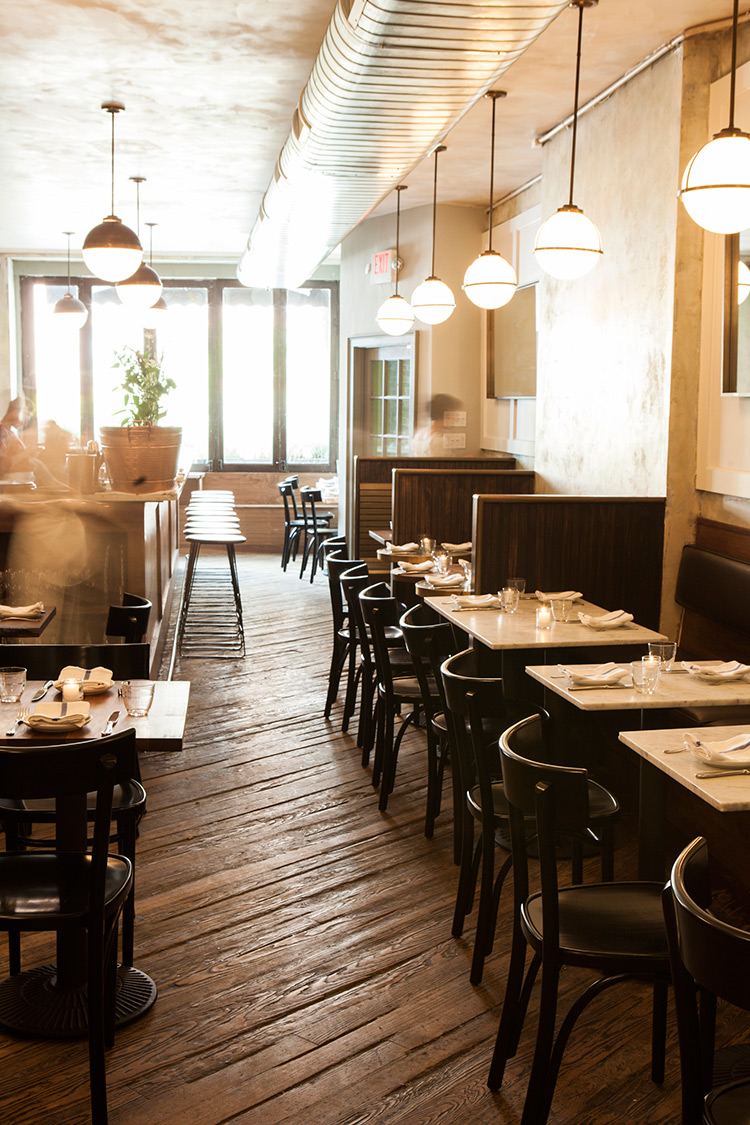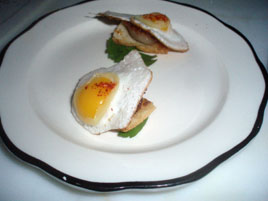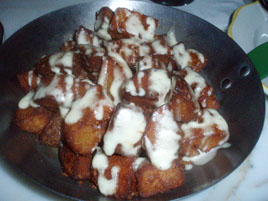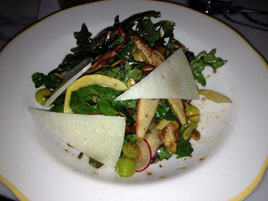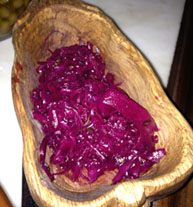

Note: Just a month after switching to a prix fixe-only format, chef George Mendes flip-flopped after regulars told him they preferred the à la carte menu. So Aldea now has the same menu every day (though there is still a $95 tasting menu). Ironically, the switch to prix fixe is what drew me back to Aldea, but obviously with the customers who mattered, it wasn’t popular.
*
 Last week, Ryan Sutton, Bloomberg’s restaurant critic, reported that Aldea has switched to a prix fixe-only format on Thursdays, Fridays, and Saturdays. The chef, George Mendes, told Sutton that the new format would “mak[e] Aldea better” and although it’s a price hike, it’s “more about the ingredients and what I’m offering.” The chef also said that he’d eventually like Aldea to be a prix fixe restaurant every night.
Last week, Ryan Sutton, Bloomberg’s restaurant critic, reported that Aldea has switched to a prix fixe-only format on Thursdays, Fridays, and Saturdays. The chef, George Mendes, told Sutton that the new format would “mak[e] Aldea better” and although it’s a price hike, it’s “more about the ingredients and what I’m offering.” The chef also said that he’d eventually like Aldea to be a prix fixe restaurant every night.
I hadn’t written about Aldea since shortly after it opened, in mid-2009. I gave it 2½ stars at the time. Every pro critic in town gave it two or three. It also won a Michlen star in 2011, which it has maintained. The Sutton piece made me curious to see what has changed.
The space remains, as I described it four years ago, “flat-out gorgeous.” It’s on the casual side of formal, but comparatively serene by today’s standards. The sound track is quiet enough not to interfere, and consists mostly of items a guy my age would recognize.
 The à la carte menu remains relatively brief, with six Petiscos, or snacks ($8–16), five selections of hams and terrines ($9–18), eight starters ($11–21), and eight entrées ($27–38). By way of comparison, four years ago $27 was the most expensive main course, rather than the least expensive. That was, of course, right in the teeth of the financial crisis, and Aldea was an unproven restaurant then.
The à la carte menu remains relatively brief, with six Petiscos, or snacks ($8–16), five selections of hams and terrines ($9–18), eight starters ($11–21), and eight entrées ($27–38). By way of comparison, four years ago $27 was the most expensive main course, rather than the least expensive. That was, of course, right in the teeth of the financial crisis, and Aldea was an unproven restaurant then.
On weekends, your choices are a $75 three-course prix fixe (probably with an amuse or two, though the menu doesn’t say that) or a tasting menu at $95. Given such a small difference, the tasting menu was the obvious choice. (Click on the image, left, for a larger copy of the menu.) We also ordered the wine pairings, which add another $50 per person, bringing the total for two to $376 including tax and tip.
The wine list remains a weakness. As it was from the beginning, it’s just one sheet of paper, printed on both sides. It’s a decent selection, and fairly priced, given that limitation. But you’d think, after four years, critical acclaim, a Michelin star, the economy in better shape, and the restaurant well past its probation, that they’d have upgraded it.
The printed tasting menu listed nine courses. Fifteen items were sent out, although many (especially early in the meal) were rather small—essentially just bites.


The amuse bouche was described as a “mojito meringue” (above left). This was followed by a number of small courses, several of which appear on the regular menu as “Petiscos.” First up was a trio of items (above right): an Island Creek oyster with Steelhead trout caviar; a terrific mussel soup with fennel and chorizo; and a Bacalhau Croqueta with roasted garlic aioli.


Then a beet floret with goat cheese sitting in moss (above left) and a dellicate poached quail egg (above right).


Finally, a remarkable warm stew of roasted bacalhau (codfish), scrambled egg, crispy potato, and black olives, served warm inside a hollowed-out egg (above left); and a dish that I believe has been on the menu from the beginning, the sea urchin toast (above right).


There was a rich Foie Gras Terrine (above left) with cranberry jam and an apple poached in vanilla. The toasted brioche (not pictured) was a considerable improvement over the untoasted country bread that the chef sent out four years ago, but he sent out only two slices of it, when four were needed.
A Diver Scallop (above right) was the evening’s one blunder. The delicate flavor of the poor scallop was overwhelmed by a bitter black radish sitting on top of it, and not redeemed by glazed turnips and hen-of-the-woods mushrooms.


A crisped brick of suckling pig (above left) suffered no harm from accompaniments of little neck clams, pickled cauliflower, carrots, and savoy cabbage; but I didn’t feel like those extra items enhanced the pig, either.
The cheese course (above right) was a Kinderhook sheep’s milk cheese from the Hudson Valley, with a wheat cracker and spice fig marmelade. (Sorry about the awful photo.)


The pre-dessert (above right) was exactly what such an intermezzo should be, a vanilla custard with mango sorbet and mint granita.
 The dessert (above left) was a lemongrass and coconut-milk panna cotta with a blizzard of other ingredients: poached kumquat, coconut-Thai basil granita, and coriander-fennel crisp. This struck me as a bit too citrus-y. Your mileage may vary. There was a plate of petits fours (right) that we were far too full to fully appreciate.
The dessert (above left) was a lemongrass and coconut-milk panna cotta with a blizzard of other ingredients: poached kumquat, coconut-Thai basil granita, and coriander-fennel crisp. This struck me as a bit too citrus-y. Your mileage may vary. There was a plate of petits fours (right) that we were far too full to fully appreciate.
The service was excellent. The meal took about 2½ hours to complete, which is a reasonable pace for this amount of food. The wine pairings were well chosen, given the constraints of the list, but I am not going to itemize them. There were seven generous pours, which was more than enough alcohol for one evening. I can’t evaluate the economics of the chef’s prix fixe experiment, but I had no trouble getting a prime-time Friday evening reservation the same day. The dining room was doing a good business, but was not full.
As is so often the case, the smaller courses at the beginning of the meal (the petiscos and appetizers) pleased us more than the main courses, although the scallop was the only dish that failed outright. No chef is going to send out fifteen courses that please everyone. Among tasting menus available in New York, this is surely one of the better ones below $100.
Aldea (31 W. 17th Street between Fifth & Sixth Avenues, Flatiron District)
Food: Modern Portuguese cuisine, liberally interpreted
Service: Upscale but not formal
Ambiance: A beautiful, fairly quiet, modern room.
Rating: ★★★
 Monday, September 22, 2014 at 08:47PM
Monday, September 22, 2014 at 08:47PM 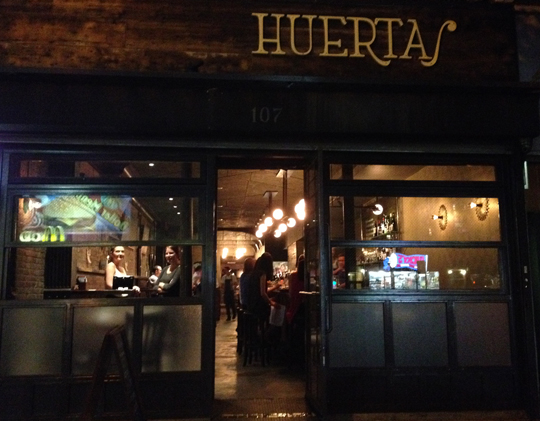
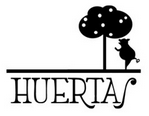 What does a restaurant have to do to get reviewed in this town? Huertas in the East Village has been open for nearly six months, and the only professional review I can find is by Robert Sietsema in Eater: three stars.
What does a restaurant have to do to get reviewed in this town? Huertas in the East Village has been open for nearly six months, and the only professional review I can find is by Robert Sietsema in Eater: three stars.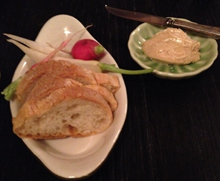 You might have predicted success, when a couple of Danny Meyer alums are in charge. Chef Jason Miller has worked at Chanterelle, Gramercy Tavern and Savoy, before joining the opening team at Maialino, where he was sous-chef. After leaving Maialino, Miller did an apprenticeship in Northern Spain—hence the Basque connection. His partner and General Manager is Nate Adler, who was beverage director at both of Meyer’s Blue Smoke locations.
You might have predicted success, when a couple of Danny Meyer alums are in charge. Chef Jason Miller has worked at Chanterelle, Gramercy Tavern and Savoy, before joining the opening team at Maialino, where he was sous-chef. After leaving Maialino, Miller did an apprenticeship in Northern Spain—hence the Basque connection. His partner and General Manager is Nate Adler, who was beverage director at both of Meyer’s Blue Smoke locations. Marc Shepherd | Comments Off |
Marc Shepherd | Comments Off | 




